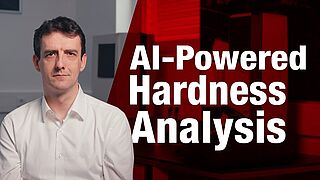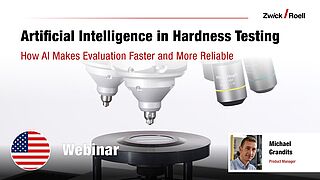How Artificial Intelligence Revolutionizes Hardness Testing
Automated hardness testing has long been standard in quality assurance. But with the integration of artificial intelligence (AI) in image evaluation, a new era begins: The newly developed AI functionality ecos AI within the testing software ecos™ III takes precision, reliability and efficiency to a completely new level – especially on difficult surfaces.
From traditional image processing to AI supported analysis
Since the early 2000s, algorithms have been used to evaluate hardness indentations. The benefits speak for themselves: Automation saves time, reduces operator influence and increases reproducibility. However, traditional image processing reaches its limits with challenging surfaces – such as etched weld seams, inhomogeneous materials such as sintered materials or oxidized specimens.
This is where ecos AI comes in: Based on machine learning methods, a system has been developed that reliably recognizes and measures indentations even under difficult conditions. The AI "thinks" like a trained tester – it recognizes typical structures and ignores disturbing image artifacts or surface irregularities.
Weak AI with a strong impact
Even if ecos AI is not "strong AI” in the sense of real machine intelligence, the testing software delivers impressive results. The image evaluation is not based on generic rules, but on millions of validated training images – specially created and manually marked. This creates a robust model that distinguishes with high certainty between a real indentation and a random shadow or spot.
Another key advantage: ecos AI does not continue to learn independently. The system works on the basis of defined models that have been centrally validated. This ensures that no uncontrolled changes occur due to incorrect training data. The results remain consistent and reliable.
90% fewer measurement errors – especially on difficult surfaces
In direct comparison to the previous segmentation technology, the AI in ecos III reduces the incorrect measurements by up to 90%. The difference is particularly evident in the case of heavily etched weld seams or coated specimen: Where the traditional algorithm can no longer be used sensibly, ecos AI delivers very good results with no or minimal post-processing effort.
Stable, offline, standard-compliant
ecos AI runs on any standard PC – a modern i5 processor is sufficient. An internet connection is not required for use or setup. All data remains local and there is no exchange with external servers. This not only makes the solution compliant with data protection regulations, but also completely independent and can be used offline.
In addition, ecos AI meets all normative requirements according to ISO, ASTM, or NADCAP. No alternative measurement approach is used – the software measures exactly as the standards prescribe.
Conclusion: More level of safety, less effort
With the AI function ecos AI, ZwickRoell has achieved a major leap in innovation in hardness testing. The AI complements the existing system seamlessly – without additional costs or additional steps for operation. It is an integral part of ecos III and ensures a noticeable improvement in the detection and measurement of indentations – especially on difficult surfaces.
The result: less manual rework, higher accuracy and more confidence in every test result.

ABOUT THE AUTHOR:
Head of Development & Innovation, EMCO-Test
Following the completion of a technical education (industrial engineering) program at the Higher Technical Education Institute in Hallein, Austria, Michael Grandits graduated from the University of Applied Sciences in Salzburg with a degree in telecommunications. After he gained initial professional experience at Sony, he switched to the automotive industry and worked in quality assurance. Since 2012, he has been a product manager in the development team at EMCO-TEST in Kuchl in the Salzburg region with the aim of inspiring international customers with user-friendly and high-quality hardness testers.

